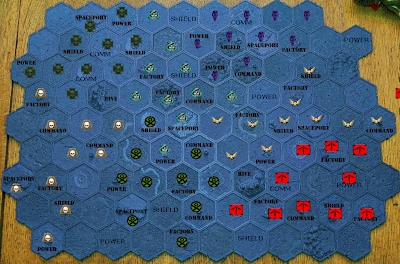Breakout
Having barely escaped the jaws of a deadly trap, your forces must break free from the battle zone and get to a safe extraction point.
Your forces barely survived an ambush by enemy forces. You must get out of range of their jamming equipment to request planetary extraction and deliver vital information regarding your attackers. This is raid mission with an attacking force and a defending force. This is an unbalanced scenario designed for a story or narrative campaign setting. The defender should expect a win or draw.
Setup - Pitched Battle; Terrain should include lots of "rural" features (trees, hills, rivers, etc...).
Forces - Standard force organization chart.
Scenario Special Rules
Defender will deploy first and take the first turn (Attacker may attempt to steal the initiative). Defender forces will fall back away from their deployment zone, towards the opposite board edge.
Mission Objective
The Defender must escape off the table edge opposite their deployment zone. If any defender forces escape off battlefield the defender will achieve a win. If the number of units who successfully escaped is more than half then the defender will achieve a draw. If zero units escape, the attacker will achieve a win. Any Defender units still on the table at the end of the game count as destroyed by the Attacker.
Reserves
Attacker units held in reserve gain the Outflank USR if desired. Defender may not Deep Strike any reserves (Does not affect attacker). Defender may not infi ltrate, but may make any Scout moves available (or outflank them if reserved).
Game Length - Standard game length or until all Defender units are wiped out or escaped (which ever comes first).
Design Notes - This mission was designed to follow the Ambushed and Betrayed mission in a narrative campaign setting. It is designed to represent the fleeing forces of the ambushed player as they attempt to make for a clear landing zone for planetary extraction. The balance is brought into play in that the Defender may easily flee the table early in the game with faster units, but that may leave more valuable units left alone to face the Attacker's forces. This makes little impact in a single game, but in a campaign with attrition and realized losses from casualties it can be a serious consideration (do I keep those land speeders on the table to help my HQ and troops get off for the win, or boost off first or second turn for the easy draw).
Creator - Sunflame
Did you like this scenario? anything you'd suggest or change? let us know what you think, add it in the comments.
Fallout Wasteland Warfare - Mission 3: The Water Treatment Plant
-
The following is a play-through of tutorial mission 3 from the FWW campaign
book, it incorporates the previous sections of the rulebook discussed in
t...
5 years ago































